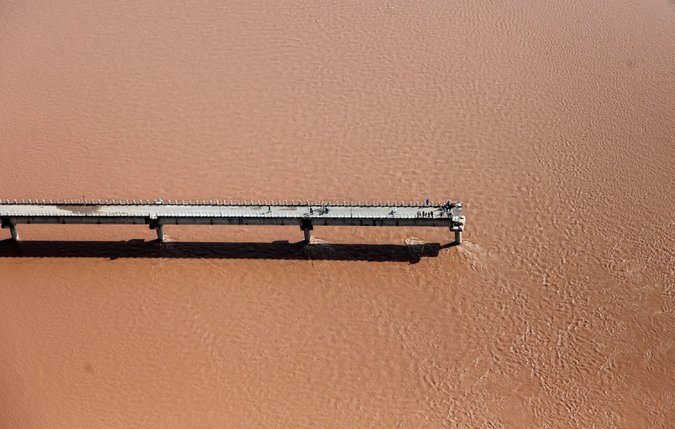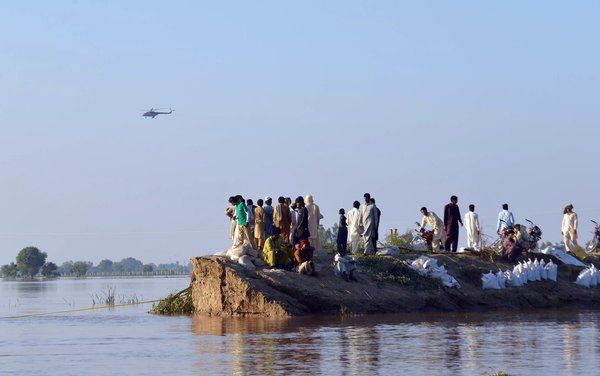Relief operations struggled on Monday in the Indian-administered portion of Kashmir and in parts of Pakistan where six days of rain and flooding have left hundreds of people dead.
On the Pakistan side of the border, Ahmed Kamal, a spokesman for the National Disaster Management Authority, said that 194 people had been killed — 64 in the Pakistani-administered part of Kashmir and 131 in Punjab Province.
Severe damage was caused by the Jhelum and Chenab Rivers, which swelled after heavy monsoon rainfall last week, flooding hundreds of villages adjoining the rivers. Thousands of people were displaced, most of them living in tents and waiting for medical supplies and food. The Pakistani military was overseeing relief efforts. On Monday, 970 people were rescued in Punjab, according to a spokesman.
The Jhelum River also breached its banks in Indian-administered Kashmir, in the summer state capital of Srinagar, where water levels rose to 15 to 18 feet at points, according to a statement from the Indian Army on Monday. At least 150 people died in the state of Jammu and Kashmir, according to the office of the divisional commissioner there.
The death toll in both countries was expected to rise as rescuers reached areas that had been inundated.
“For the next 48 hours our focus will remain on Srinagar and areas of south Kashmir because there are still a very large number of people stranded without food and water, and our idea is to pull them as quickly as possible,” Lt. Gen. D. S. Hooda, chief of the Indian Army’s Northern Command, said at a news conference in Udhampur on Monday afternoon.
Telephone networks in Srinagar were down for much of Monday, and the police, the army and the special police forces in the city could not be reached.
Shakeela Rahman, 34, spent the past few nights sleeping on a divider on a road that connects Bemina, where she lives, to Srinagar. She fled her home with her two small children early Friday morning, after water started flowing into houses there.
“We have not eaten anything, my kids are starving, and our house is completely submerged under water,” Ms. Rahman said. Nearby, a camp for the Central Reserve Police Force was also flooded, and its personnel had spent the evening sleeping in buses parked outside.
In the Karan Nagar neighborhood of Srinagar, where Ahmad Mujtaba, his wife and three children were trying to reach the higher parts of the city, the water level rose several feet on Sunday.
“No one came to help us,” he said. “People are still trapped inside their buildings, children are dying and the government’s rescue operations have failed.”
O. P. Singh, an official with the Indian National Disaster Response Force, said that rescue efforts were slow in parts of Srinagar.
“We are facing some difficulty, and there is no communication with our rescue teams,” Mr. Singh said.
“It is practically impossible to go through the area with boats,” he said of parts of Srinagar. He said rescue operations in those areas had just begun, with Indian Air Force helicopters ferrying boats and rescue personnel between hard-to-reach areas of town, where they were collecting stranded people and bringing them to relatively safer areas.
The army has evacuated about 22,000 people, with 3,000 removed on Sunday, according to a statement. The army distributed food, water, tents and blankets on Monday.
Part of the army quarters in Srinagar was flooded, and 900 soldiers had to be evacuated. Hospitals in Srinagar were also submerged.
Aerial images on Indian news channels showed entire neighborhoods in the Kashmir Valley under water, with only roofs and treetops visible. People in Srinagar waded through muddy, hip-deep water, carrying children on their shoulders.
Prime Minister Narendra Modi visited Jammu and Kashmir on Sunday, calling the floods a national disaster. In a news release, he also expressed his “anguish at the loss that has been caused in neighboring areas in Pakistan-occupied Kashmir.”
He said the government would provide $166 million to Jammu and Kashmir to supplement the state’s own disaster relief fund.
Mr. Modi also wrote to Prime Minister Nawaz Sharif of Pakistan on Sunday. “I offer any assistance that you may need in the relief efforts that will be undertaken by the Government of Pakistan,” he said. “Our resources are at your disposal wherever you need them.”
Mr. Sharif declined Mr. Modi’s offer. After surveying the damage in the Rawalakot district of Kashmir on Monday, he pledged assistance and called for “addressing the deeper causes of recurrent floods and strengthening the preparedness” of local communities, according to a statement issued by his office.
“I believe closer collaboration in disaster management should be a part of our agenda for peace and development in the region,” Mr. Sharif said.
Some Pakistanis have blamed India for suddenly releasing river water into Pakistan, violating an understanding of giving warning before opening dams. The disaster also put additional strain on the government of Mr. Sharif, who is grappling with a monthlong political crisis caused by opponents demanding his resignation.
Hafiz Muhammad Saeed, the leader of the militant group Lashkar-e-Taiba, accused India of committing “water aggression,” according to local news media.
Relations between India and Pakistan were strained last month when India called off foreign-secretary-level talks with Pakistan after a Pakistani envoy met with Kashmiri separatist leaders in India.
The Ministry of Foreign Affairs in Pakistan on Sunday expressed “deepest condolences over the loss of precious lives of our Kashmiri brethren on both sides of the Line of Control,” the contested border dividing Kashmir between India and Pakistan.
As floodwater moved downstream, an emergency was declared in Baluchistan Province, according to government officials.











